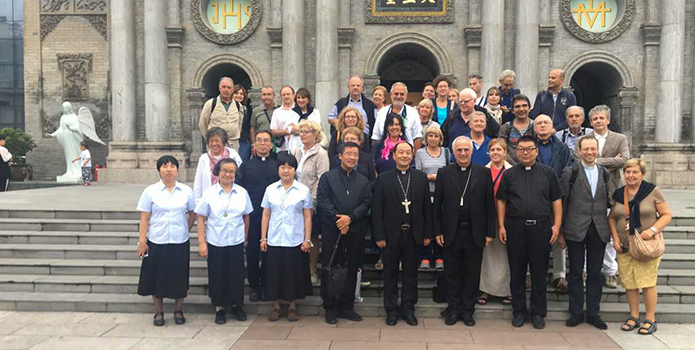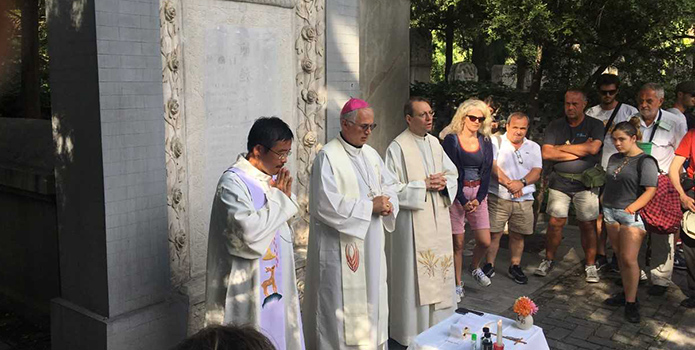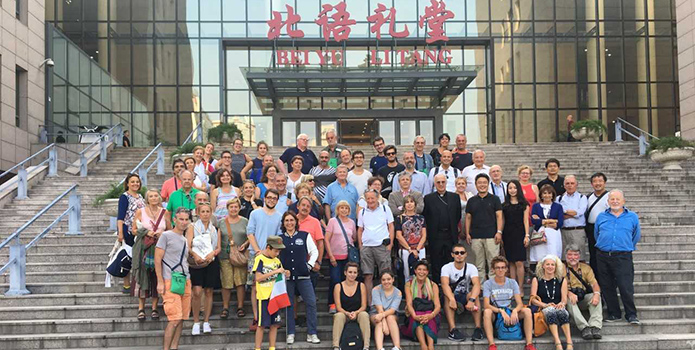Tour of China - In the footsteps of Fr. Matteo Ricci S.J. - 2017
Interview with H.E. Mons. Claudio Giuliodori
Cultural Journey to China in the footsteps of Fr. Matteo Ricci
22-31 August 2017
Who are the participants in the trip and why, after the Holy Land and Santiago de Compostela, was China chosen as your destination?
The Cultural Trip organized by the Pastoral Center of the Catholic University of the Sacred Heart was attended by 20 professors of the University with their families and friends for a total of 62 people. The high number of participants, much higher than that of previous experiences, confirms the University's great interest in internationalisation processes and, in particular, in what is happening in the East and especially in China.
Università Cattolica maintains relationships with academic institutions in Shanghai and Beijing. What are they? And what are the areas of collaboration and ongoing projects? What are the further development prospects?
There are now hundreds of Chinese attending the various Faculties or Masters of Università Cattolica. Then there are the relationships and institutional projects that see us involved in joint initiatives with some Chinese universities in Shanghai and Beijing. It is in this context that we visited the Department of Philosophy and Religious Studies at Fudan University in Shanghai and BLCU-Beijing Language and Culture University in Beijing. With the latter institution, collaboration passes in particular through the Confucius Institute, which is also present at our University, and some projects that allow double degrees to be obtained in both universities.
Among the various visits, the one to the tomb of Matteo Ricci, the Jesuit who shared Western culture with China and, at the same time, was able to enter the heart of the country through the knowledge of the language and culture, in short, a free and respectful cultural exchange.
The whole journey had as its leitmotif the testimony and teaching of the great Jesuit from Macerata (Macerata 1552 - Beijing 1610) who marked Chinese cultural and scientific history by following new and fascinating paths for evangelization. As soon as we arrived in China, we visited the Xu Guangqi Memorial Hall, which commemorates the most important Chinese collaborator of Fr. Matteo Ricci, one of the first to be baptized with the name of Paul and one of the most representative imperial officials of his time. He was Minister of Agriculture and Defense and even Prime Minister under the Ming Dynasty. In Beijing we then visited the Cathedral of South Nan Tang built exactly in the place granted by the emperor for the settlement, starting in 1601, of the first Jesuit community led by Fr. Matteo Ricci. In addition to visiting the Ancient Astronomical Observatory, where the presence and work of the Jesuits in the field of astronomy in China is well documented, we experienced the highest and most significant moment of the trip with the celebration of Holy Mass on the tomb of the illustrious Jesuit which is located in the garden of what is currently the headquarters of the Communist Party in Beijing.
What is your message today to an educational and cultural institution such as Cattolica?
The particular admiration that the Chinese people express, even today, for Li Madou (the Chinese name of Fr. Matteo Ricci) confirms the greatness of his missionary method that was able to decline the proclamation of the Gospel through all the avenues of culture, science, art and dialogue, both philosophical and religious. His message, therefore, is also extraordinarily timely for an institution such as Università Cattolica, which has the task of forming the new generations in a knowledge open to all knowledge, starting from a vision inspired by Catholic universalism and the sincere search for truth.
A further stage of the journey was the meeting with the women's congregation founded by Armida Barelli. What emerged from this comparison? What is the face of this congregation today?
The stop we made in Xi'An, the ancient and glorious imperial city - today famous above all for its terracotta army - could not miss the meeting with the religious congregation founded by Armida Barelli in 1923, in the same years in which Università Cattolica was taking its first steps. Barelli has never been to China, but supporting the Chinese missions was a dream of hers, cultivated since her youth, which came true with the creation of a women's religious order that still today has 250 Chinese nuns at the service of the Diocese and some educational and charitable institutions.
What value does it have today to promote opportunities for meeting, getting to know and dialogue with China? Beyond cultural exchange, the Pope points out to us the building of bridges of dialogue as the main road to world peace and balance. In this perspective, what role can China play in the Europe/Asia, West/East dialogue?
A simple cultural trip like this is enough to realize what development and what political, economic and cultural relevance China is assuming for internal changes and for its role in the world arena. It will not be possible to think about the future of the planet without confronting this great people who number about one and a half million people and who are experiencing one of their seasons of greatest dynamism and growth, obviously with a complexity of situations and problems whose outcomes are not easy to predict. It is evident that every initiative of dialogue and encounter, in the "style of friendship" taught by Fr. Matteo Ricci, can only facilitate knowledge, esteem and collaboration for a journey, as also hoped for by Pope Francis, of peace, concord and harmony, terms so dear to traditional Chinese culture and also preparatory to the acceptance of the Gospel.


